
Yadoroku is a little onigiri specialty store in the heart of Asakusa, and as far as such onigiri specialty shops go, it is also Tokyo’s oldest one. Yadoroku was founded in 1954, a time when white rice was a luxury item called ginshari due to food shortages after WWII.
In that time, it is said that the shop sold about 100 onigiri every single day. It was even featured as a Michelin Guidebook Bib Gourmand in 2019. LIVE JAPAN talked to Yosuke Miura, Yadoroku’s third-generation shop owner, about the deliciousness of onigiri, his shop’s location at the backside of Senso-ji Temple, and what kind of onigiri are especially popular with international customers.
Onigiri - International Fame Through Anime?

Yadoroku offers eighteen different kinds of onigiri, such as kelp, salted fish, and chili pepper leaves, ranging from 270 yen to 680 yen (tax included).
The onigiri specialty store was opened by Miura’s grandmother and now, his mother operates the shop in the evening while he represents the third generation during lunch. Two tables offer space for four people each while eight more chairs stand at the counter.
During lunch, people queue up outside of Yadoroku to get a taste of the shop’s special lunch set.
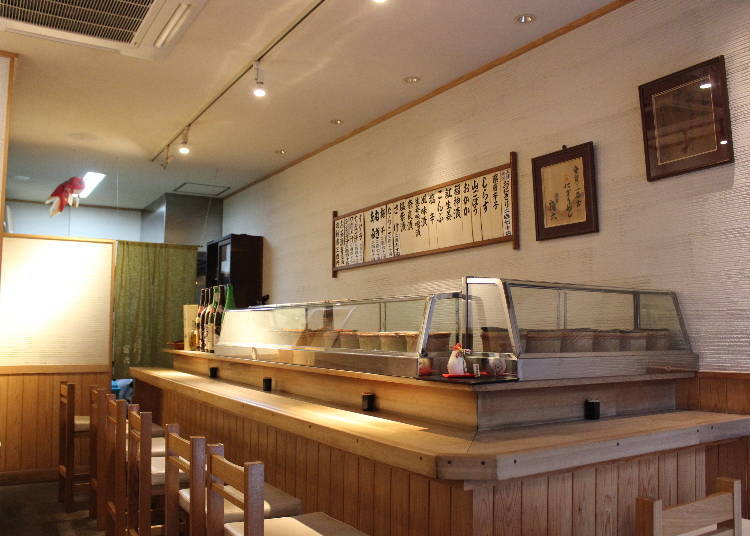
“This has been an onigiri specialty shop since the time of Yadoroku’s founding. At first, it was only open in the evening, but ever since I started working here as well we were able to also open for lunch. Ever since then, we have a lot of tourists among our guests. Before that, we maybe saw two international guests per year but now we welcome them every day.”
The launching of an English version of Yadoroku’s official homepage is one of the reasons why tourists manage to find the shop despite its location behind all the major sightseeing attracting. Another reason is Lonely Planet, a guidebook that features Tokyo’s oldest onigiri shop on its pages. People who visited Yadoroku already post pictures and information about it on social media, others find the rice ball paradise in free booklets and pamphlets all around Asakusa.
“We also felt the influence of anime. Everyone knows onigiri from their favorite shows, such as Pokemon and Naruto, in which the main protagonists can be seen eating this black and white food. A lot of our international anime fan customers come from France and Taiwan, it seems. There was someone who befriended a Taiwanese person, and that person then wrote about it on their blog. That also seems to be a big influence. As for the western world, we have more Europeans than people from the United States, such as Italians and the aforementioned French. Australian people also come to eat our onigiri a lot.”
Red Stuff is Good, White Stuff is Boring?

What kinds of onigiri do international tourists order?
“People usually don’t know or understand the ingredients, so they choose by appearance. Red onigiri seem to be the most popular, such as the red pickled ginger one. “It’s red, and it’s ginger!” is something we hear quite often. Besides that, salmon and ikura, salmon roe. We have an English menu but people often don’t know what the ingredients taste like. When I am asked, I recommend opossum shrimp and ginger miso. People from Asia seem to like ginger miso a lot. Europeans, I think opossum shrimp and young sardines are good. Sour tastes don’t seem to work so well.”

Which onigiri is the least popular, then?
“People like red and do not order things like shirasu, those young sardines I mentioned, and kasuzuke, things pickled in sake lees. White food isn’t eaten that much in other countries, I think. Generally, our international guests don’t like sour onigiri, but there are those who do enjoy ume, pickled plum.”
Yadoroku’s Definition of Delicious Onigiri
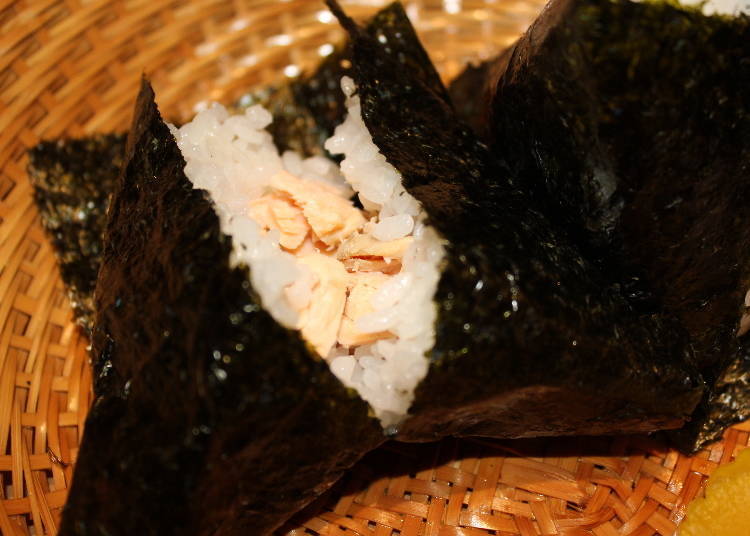
Yadoroku’s onigiri are freshly prepared with every single order, which means that the rice is still wonderfully warm and the nori wrapped around it is too big in a way that makes it just right. With the first bite, the crunchy nori gives in and reveals the rice delicacy inside.
“The first bite is supposed to be plain rice. The second bite will let you taste the filling.”
Eating the onigiri from the top, which is also called “from the mountain” in Japanese, will indeed give you rice and nori at first. The second bite, however, featured so much salmon that the thought of finishing the rice ball seemed impossible. What makes an onigiri delicious?
“Well, the worst mistake to make is to be stingy with the ingredients. Like with sushi, the selection of ingredients is very important. Cooking high-quality rice just the right way, using choice ingredients for the filling, and wrapping everything up in high-quality nori. The shape can be anything, really, and if you yourself like the taste, it’s good. If you have problems with the triangle shape, simply use a chopping board to help with that.”
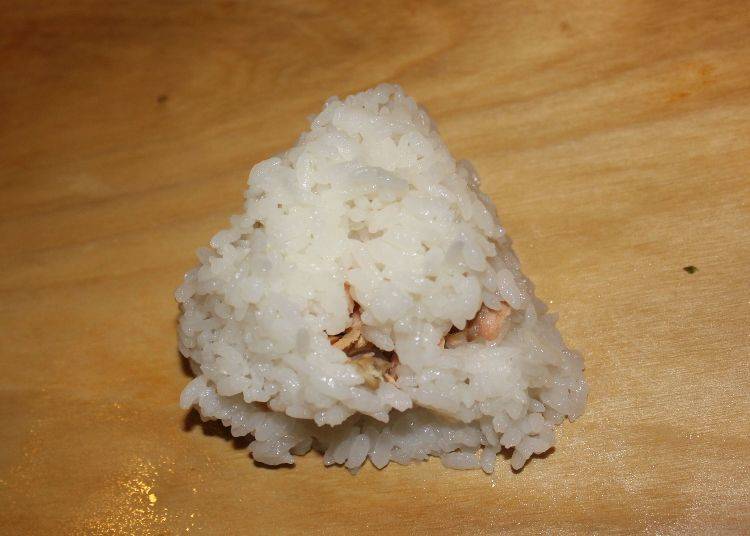

Searching for the Balance between Rice, Filling, and Nori
“If you yourself like the taste, it’s good,” says the onigiri master. At first, this statement seems somewhat lackadaisical, but the more Yosuke Miura speaks, the more his passion for onigiri shines through.
“I have eaten my grandma’s onigiri since I was a little kid so their taste is my standard. Since I entered the business, I did try out other onigiri shops but I think that our Yadoroku is the most delicious one. So, our onigiri being the best is my standard.”
As such, it seems that studying at another shop or restaurant was out of the question. He thinks that his mom is the type who wouldn’t say anything if the onigiri didn’t taste good. So Yosuke Miura trusts his own judgment, and this is where his statement comes from. On top of that, he taught himself how to cook rice and since he thinks “rather scientifically,” he was in constant contact with rice cooker makers, exchanging information. Apparently, he is pursuing the most delicious rice to this very day. By the way: the rice used at Yadoroku is choice koshihikari, made in a cooking pot for rice called hagama.

“I decide the size of my onigiri by what I think is easiest to eat. My mother’s onigiri are slightly bigger than mine, although the taste is the same. The amount of rice and the amount of filling depends on the ingredients. There needs to be a balance. My onigiri have around 70 grams of rice, and in relation to that, I decide how many grams of salmon or how many grams of salted fish are best. In the end, it entirely depends on one’s individual taste, but there is such a thing as a perfect balance. Our regular customers say that my onigiri taste different than the onigiri of my mother, even though we use the same ingredients. My red pickled ginger onigiri seem to be the better ones. (laughs) The onigiri of chain stores have too much rice and too little filling for my taste.”
The Onigiri Master’s Bold Experiments with Ingredients and Flavors
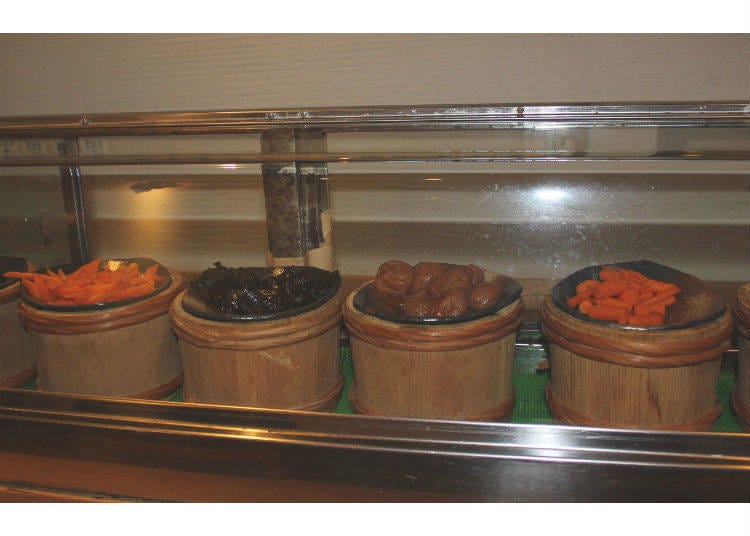
The current menu is primarily made up of the very things that were put there by Yosuke Miura’s grandmother, 63 years ago. Recently, brown rice balls have become increasingly popular, but there is a reason why those and other popular fillings are not on Yadoroku’s menu.
“I am always on the lookout for ingredients, and when I see something that I think might be delicious inside an onigiri, I buy it to try it out. I tried out a lot of fillings up until now, but the only one that made it on the regular menu is ami, the opossum shrimp. All other onigiri are from the time of the shop’s foundation. I think that those are very well thought out.”
What kind of ingredients did you try, then?
“Things such as mustard-filled lotus root. I thought ‘this is delicious!’ But when I turned it into an onigiri, it did not really fit. For example, I really like eating mentaiko, spicy cod roe, by itself but not as an onigiri filling. It doesn’t seem to fit the nori, there’s just something not quite right with the taste. Another one is chirimen-zansho, small dried fish and Japanese pepper berries. One-hundred grams of that cost 2,000 yen, but it turned out to be entirely useless as an onigiri filling. It was good with rice but it didn’t work at all with the nori. After all, everything is about the balance of rice, the filling, and the nori.”
With the recent healthy food boom, we do see things like brown rice onigiri. You seem to be an opponent of this, however?
“Brown rice just doesn’t fit my philosophy. I grind my white rice, removing the little yellow parts, then cook it with great care. I do all of this to make the rice as delicious as possible, and to serve it with commitment.”
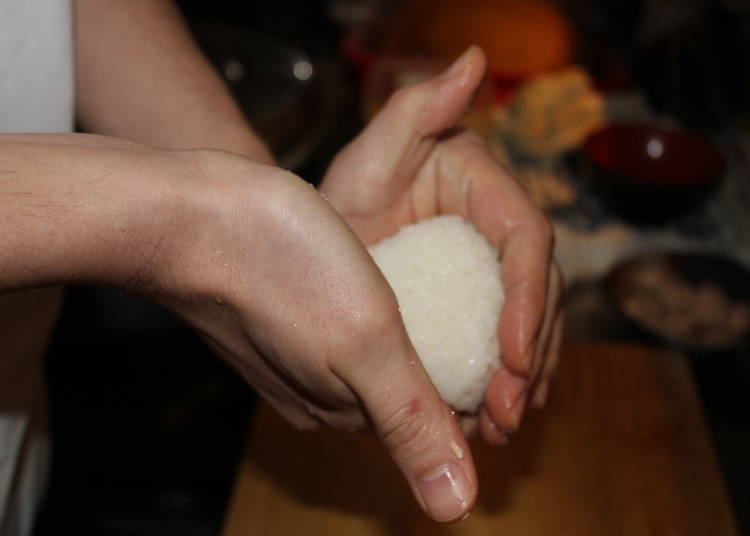
Having perfected the balance of ingredients, can you tell us about shaping the onigiri?
“That’s a question you would also ask a sushi chef, wouldn’t you? And it’s not that different at all. Of course, the technique is one of the most important parts. A part-timer, for example, wouldn’t be able to make good onigiri just like that. The topping, the rice, and the shape are the three things one thinks of when talking about sushi making, and onigiri is pretty much the same. Nonetheless, people see onigiri as inferior to sushi, don’t they?”
We probably ask this question without thinking much of it, as onigiri is a food we’re very familiar with. For a specialty chef and restaurant, however, this distinction between onigiri and sushi naturally feels unfair. Using choice ingredients, Yosuke Miura’s perfected balance and perfected way of shaping cannot be imitated easily.
While tourists populate Yadoroku during lunch, local people flock to the specialty shop for one last onigiri before going home at night and in the evening. Yadoroku actually does serve serves alcohol in the evening – but only one cup, it is an onigiri specialty shop after all. A framed writing hangs on the wall, written by a friend of Yosuke Miura’s grandmother for his grandfather. This makes its meaning even more humorous and sets the stage for the friendly, casual atmosphere in the store. By the way: the term “yadoroku” also carries the meaning of “good-for-nothing husband.”

The history of onigiri dates back to the Yayoi period, around 300 BC to 400 AD. In the Sengoku period, the time of Japan’s warring states, it was an invaluable meal for soldiers, until the onigiri became school lunch in the Meiji era.
The classic rice ball snack may be over 2,000 years old, but even nowadays it is loved by both young and old, with various different varieties of the onigiri being sold in convenience stores and supermarkets all over Japan.
A recent trend is trying to make the onigiri a Japanese soul food – in any case, it certainly is a staple dish for Japanese day to day life. Why not try to find that perfect balance of rice, filling, and nori for yourself? Remember: if you think it’s good, then it’s good.
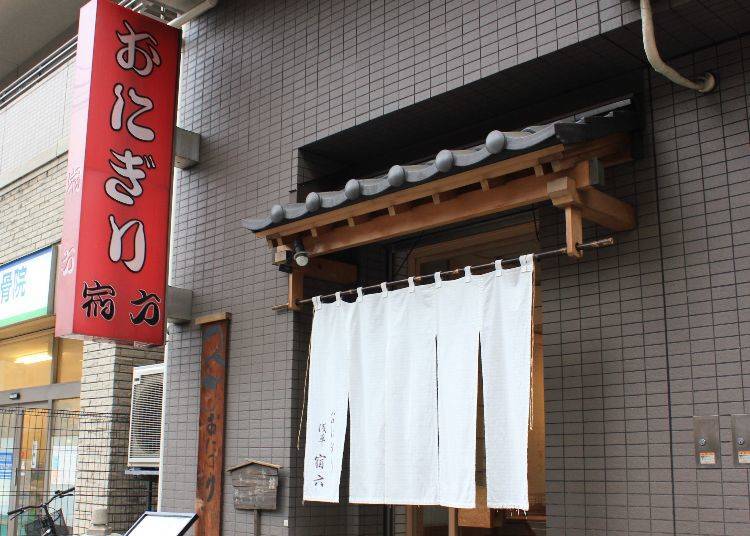
-
Onigiri Yadorokuおにぎり浅草宿六
- Address 3-9-10 Asakusa, Taito-ku, Tokyo-to 111-0032
- Phone Number 03-3874-1615
Hours: 11:30 a.m. - 5:00 p.m., 6:00 p.m. - 2:00 a.m.
The shop closes when it runs out of rice.
Closed: Sundays for lunch, Wednesdays in the evening
Seats: 8 counter seats, 2 tables with 4 seats each
All seats are non-smoking.
- Area
- Category
*Prices and options mentioned are subject to change.
*Unless stated otherwise, all prices include tax.
Popular Tours & Activitiess
Recommended places for you
-

Ueno Zoo (Ueno Zoological Gardens)
Zoos, Aquariums & Botanical Gardens
Ueno
-

Wasui Yaesuten
Other Japanese Food
Tokyo Station
-

wagyuutokome Nakatake
Other Japanese Food
Ginza
-

Azabumaguro Shofuku
Other Japanese Food
Roppongi
-

MomotaroUeno
Other Japanese Food
Ueno
-

Tempura Asakusa SAKURA
Other Japanese Food
Asakusa
-
Ad

(Opening in Jan 2026) 'THE SUMO LIVE RESTAURANT HIRAKUZA GINZA TOKYO!' 5 Exciting Ways to Experience the World of Sumo!
-
Ad

Discover the "Miraculous Forest" in the Heart of Tokyo: The Institute for Nature Study (9 Minutes from JR Meguro Station)
-

Jujutsu Kaisen Takes Over JR East With a Wrapped Shinkansen This Winter
by: Guest Contributor
-

First Japan Cherry Blossom 2026 Forecast Announced! Here's When & Where to See Sakura in Japan
-

Strawberries, Style, and Tokyo’s Coolest Neighborhood: Winter Afternoon Tea in Kichijoji
by: Guest Contributor
-

New in Ginza! Air BicCamera Ginza Opens with a Faster, More Convenient Shopping Experience
by: Guest Contributor
Inspiration for Accommodations
-

Enjoy Mt. Fuji from the Comfort of Your Room! Recommended Ryokan with Mt. Fuji View
-

Stay Near the Cherry Blossoms! Hotels for Cherry Blossom Viewing in Tokyo
-

Family-Friendly Hotels with Free Shuttle to Disneyland: Convenient Access for a Magical Stay
-

Top Ranked Hakone Hotels with Mt. Fuji View: Enjoy Stunning Scenery from Your Private Space
-

Convenient Tokyo Hotels with Airport Shuttle: Ideal for Families and Heavy Luggage
-

Stunning Tokyo Tower View Hotels: Enjoy Spectacular Scenery from Your Private Space
-

Convenient Asakusa Hotels with Kitchens: Ideal for Extended Family Visits
-

Experience Luxury: Hakone's 10 Best Five-Star Accommodations
-

Enjoy Mt. Fuji Autumn Leaves! Top Hotels Near the Popular Autumn Leaves Corridor
-

Experience Hakone Fall Foliage from Your Room with Stunning Views
-

What to Pack for Japan: 8 Essential Things for a Hassle-Free Trip
-

Budget Dining: 11 Popular Spots for Japanese Food in Yokohama and Tokyo!
-

Shibuya Crossing: Getting the Best View from the Deck at Magnet by Shibuya109!
-

Top 7 Popular Japanese Mushrooms That Are Both Tasty and Healthy
-

Italian Restaurants in Tokyo
-

Solo Traveling: Enjoying a Tasty Night Out in Tokyo!
- #best ramen tokyo
- #what to buy in ameyoko
- #what to bring to japan
- #new years in tokyo
- #best izakaya shinjuku
- #things to do tokyo
- #japanese nail trends
- #what to do in odaiba
- #onsen tattoo friendly tokyo
- #daiso
- #best sushi ginza
- #japanese convenience store snacks
- #best yakiniku shibuya
- #japanese fashion culture
- #best japanese soft drinks












